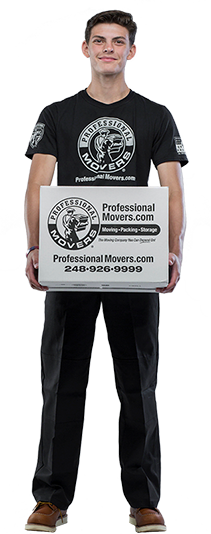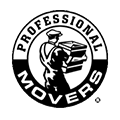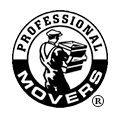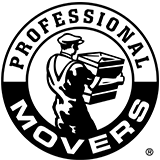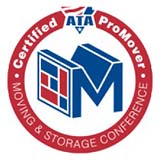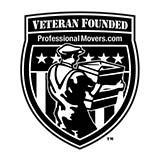The Best Packing Tips & Guides
Pack like a pro with Professional Movers.com, your ultimate resource for stress-free packing
Start Here to Learn the Packing Basics
Packing your belongings for a move can be a daunting task, but with the right approach, it can be manageable and stress-free. If you plan to pack everything yourself, it’s important to start early and learn the packing techniques used by the professionals. Packing an entire house can be more involved than you might think, so don’t wait until the last minute. Begin by packing the non-critical areas of your home well in advance of the move. Packing just a few cartons each day can make a big difference in the long run. Follow these basic packing tips to ensure your items are protected and organized during transportation:
- Limit carton weight to 50 pounds or less: This will make it easier to handle and transport.
- Wrap items carefully: Protect your items by wrapping them packing paper. For fragile items such as fine china and crystal, use extra cushioning and bubble wrap to prevent breakage.
- Use sturdy cartons: Choose cartons that are strong and can be closed or sealed completely to prevent items from falling out or getting damaged.
- Pack items from the same room together: This will make it easier to unpack and organize your belongings at your new home.
- Pack in layers: Start with a layer of crushed paper or cardboard at the bottom of the carton for cushioning. Then, add the heaviest items at the bottom, followed by medium-weight items, and lightest items on top. Fill any empty spaces with more crushed paper or cardboard.
- Label your cartons: Clearly label each carton with its contents and the room it belongs to. Use a notebook to keep track of each carton’s contents for easy reference.
- Prepare high-value items for inspection: Leave cartons containing high-value items open for inspection by the moving supervisor.
- Pack wisely: Pack out-of-season and infrequently used items first. Leave items you’ll need until moving day organized and ready to pack a few days prior to your move date.
- Indicate priority boxes: Mark cartons that you want to unpack first at your destination.
By following these simple packing tips, you’ll be able to pack your belongings like a pro and ensure they arrive at your new home safe and sound. Using the correct materials is also crucial. Professional Movers.com has a full range of specialized cartons and packing materials available for our customers to use. It’s important to note that there are certain items that cannot be transported due to being combustible, flammable, and/or caustic. Please review our list of Non-Allowable Items for a complete list of items that cannot be moved.
Packing Tips for Most Common Household Items
Here is a quick overview on how to pack many household items the same way our professional packers do.
Artificial Flowers
- An arrangement of artificial flowers should be packed in its own carton. Wrap carefully in plastic wrap, tissue paper or paper towels. If possible, fasten the base of the floral piece to the bottom of the carton. Label the carton “FRAGILE – THIS SIDE UP.”
- For instructions on moving live plants, ask your Moving Consultant for additional tips.
Books
- Pack them either flat or with the spine touching the bottom of the carton. Do not pack with spine facing up, as glue can break away from the binder. Pack books of the same general size together.
- Expensively bound volumes or those of special sentimental value should be individually wrapped before packing. Because books are heavy, be sure to use small cartons.
Bowls & Odd-Shaped Items
- Depending on their weight, these might be used either as the bottom or middle layers. Wrap the same way as flat plates.
- Stand shallow bowls (soup plates, etc.) on edge in the carton and deep ones (such as mixing bowls) nested two or three together, upside down on their rims.
- Wrap sugar bowl lids in tissue, turning them upside down on top of the bowl. Then, wrap both together in clean paper, followed by an outer double layer of newspaper. Wrap cream pitchers in clean paper and then a double outer wrapping. Place sugar bowls, cream pitchers, sauce containers and similar pieces upright in the carton. Complete the layer as for plates.
China, Glassware & Silverware
- Professional Movers.com packers use a dish pack box (exceptionally sturdy, corrugated carton of double wall construction) for china, glassware and other fragile items less than 18 inches in size. Unless cartons of similar strength and construction are available, you might want to purchase several dish packs from Professional Movers.com.
- Wrap all pieces of china and glassware individually in clean paper. Using several sheets of paper, start from the corner, wrapping diagonally and continuously tucking in overlapping edges. A double layer of newspaper serves well as an outer wrapping. A generous amount of paper padding and cushioning is required for all china and glassware. Label cartons, “FRAGILE – THIS SIDE UP.”
Clothing
- Clothing left on hangers and placed in wardrobe cartons used by Professional Movers.com will arrive at destination wrinkle-free. You might want to purchase several of these special cartons from Professional Movers.com. One will hold about two feet of compressed clothing on hangers.
- If wardrobe cartons are not used, each garment should be removed from its hanger, folded and placed in a suitcase or a carton lined with clean paper. Some lightweight clothing, such as lingerie and sweaters, may be left in bureau drawers.
- Hats may be left in hatboxes and placed in a large carton. Or, stuff the crown of each hat with crumpled tissue paper; wrap tissue loosely around the outside and place in a carton lined with clean paper, with the heavier hats on the bottom. Don’t pack anything else with hats. Label the carton “FRAGILE.”
- Footwear may be left in shoeboxes and placed in a large carton. Or, wrap each shoe individually and then in pairs. Footwear should be cushioned to avoid damage to heels or ornaments. Don’t pack heavy items on top of shoes.
- It is recommended that you take your furs with you rather than having them moved on the van.
Compact Discs, Tapes & Records
- Remove these items from the stereo or storage cabinet. Keep in mind records are heavy and should be packed in small cartons.
- If records are not in jackets, wrap individually in tissue paper or plastic wrap to protect them from being scratched.
- Stand compact discs and records on edge, never flat, on a layer of crushed paper. Support at both ends with a large, hardcover book or several pieces of cardboard cut to fit. Top with another layer of crushed paper. Identify contents on the outside of the box and mark “FRAGILE.”
- Cassette tapes should be placed in the protective plastic box in which they came, if possible, and then wrapped individually in crumpled paper. Place individual tapes either vertically or horizontally on a couple of layers of crushed paper.
Cups
- Even when using a dish pack and mini-cells for china, wrap cups individually, protecting handles with an extra layer of paper. Then, pack cups upside down.
- If not using a dish pack or cells, wrap cups as previously described in a double layer of paper and place them upside down on rims in a row on an upper layer with all handles facing the same direction. Complete the layer as for plates.
Draperies & Curtains
- Clothing wardrobes are ideal for moving curtains and draperies. Fold them lengthwise, place over a padded hanger, pin securely and hang in the wardrobe.
- Draperies and curtains also may be folded and packed in cartons lined with clean paper or plastic wrap.
Electronics
- The popularity of home electronic items has added a new dimension for the do-it-yourself packer. Home computers, microwave ovens and stereo systems require special care to ensure they arrive at the destination safely.
- If you saved the original cartons and packing materials in which these items arrived, it is best to repack them using those materials. Should you not have these materials, you might want to contact a store selling your particular item and ask if discarded packing materials are available.
- Professional Movers.com packers are familiar with current techniques for properly packing electronic items and can assist you with advice, or pack the items for you. It is your responsibility to disconnect electronic items prior to packers’ arrival.
Figurines & Other Delicate Items
- Wrap first in tissue paper, paper towels or facial tissue. Then, wrap carefully in newsprint that has been crushed and flattened out. Be sure the items are well-protected with plenty of cushioning.
- Small mirrors, plaques and pictures should be wrapped individually in tissue paper. A bath towel or small blanket makes an excellent outer wrapping and padding for glass.
- Place items on edge in a carton.
Flat China & Glassware
- Larger china and glass plates, platters and other flat pieces are excellent as the lowest layer in a dish pack.
- Place cushioning material in the bottom of a carton. Wrap each piece individually then wrap up to three in a bundle with a double layer of newspaper. Place these bundled items in the carton in a row on edge.
- Surround each bundle with crushed paper, being careful to leave no unfilled spaces. Add two or three inches of crushed paper on top of the bundle to protect rims and make a level base for the next tier. Horizontal cardboard dividers can be helpful in keeping layers level.
- Smaller plates, saucers and shallow bowls can make up a second layer. Wrap and pack in the same way as larger items.
Food
- Take only food items you are sure will travel well. Do not take anything perishable. In the winter months, do not take anything subject to freezing.
- Open boxes of dried or powdered foods such as rice, macaroni and cereals should be sealed with tape. Small containers of herbs and spices, condiments, bouillon cubes, gelatin, flavorings, etc. should be placed together in a small box before packing in a large carton. Cover holes of shaker-type containers and seal with tape.
- Since canned goods are heavy, the amount placed in one carton should be limited.
Fragile Items
- Many moving companies use a material called bubble pack (plastic with bubbles) for exceptionally fragile items. If an item is extremely valuable as well as delicate, it might be wise to have it packed for you. Special materials might be needed for maximum protection.
Glass Table Tops, Marble Slabs, Large Mirrors, Paintings, Statues & Large Vases
- All are easily damaged. Glass might shatter, and marble slabs can crack at veins. Paper never should be permitted to touch the surface of an oil painting.
- It’s best to consult with your Certified Packing Consultant about custom-made cartons and crates for items of this kind.
Lamp Bases
- After removing the light bulb and lamp harp, wrap the base, harp and bulb separately in newsprint. (Use paper pads for large lamps.) Place them together in a carton, filling spaces with crushed paper. More than one well-cushioned lamp may be packed in a carton.
Lamp Shades
- Never wrap lamp shades in newspaper. Carefully wrap each shade in three or four sheets of tissue paper, a pillowcase or a large lightweight towel.
- To allow for movement, use a sturdy carton at least two inches larger all around than the largest shade. Line it with clean paper, using crushed paper under the lamp shade to create a protective layer, but not around the shade. A small shade can be nested inside a large one, if you are sure they will not touch. Only one silk shade should be placed in a carton to avoid stretching the silk.
- Do not pack other items with shades. Label cartons “LAMP SHADES – FRAGILE.”
- It is best to have the moving company crate large Tiffany-type or other glass lamp shades or chandeliers.
Linens & Bedding
- Blankets, sheets, tablecloths, towels, pillowcases and other linens may be protected by a large plastic bag and packed in a carton that has been lined with clean paper.
- Wrap your most prized linens in tissue. Also, linens and bedding are good for cushioning or padding many types of items.
- Special mattress cartons in various sizes are available from Professional Movers.com for a nominal charge. Pillows may be placed in bureau drawers or packed in cartons.
Major Appliances
- Pre-move preparation is required for many major appliances. Set an appointment with a service technician to prepare your major appliances for shipment or have your agent send someone out who is authorized to perform this service.
Outdoor Equipment
- Before moving day, dismantle children’s swing sets, TV antennas and garden sheds. Gather pieces and bundle together with nylon cord. Place small hardware bag securely attach to corresponding equipment.
- Prepare lawn mower by draining gasoline and oil prior to the day of loading.
Photographs
- Pack them either flat or with the spine touching the bottom of the carton. Do not pack with spine facing up, as glue can break away from the binder. Pack albums of the same general size together.
- Expensively bound volumes or those of special sentimental value should be individually wrapped before packing.
- Because photographs and albums are heavy, be sure to use small cartons.
Rugs
Rugs can be rolled up end to end with our without a non-slip rug pad. The center of the rug can be taped or for larger rugs, each end can be taped as well to prevent unraveling during transportation.
Silver
- Because air causes silver to tarnish, all silver pieces should be enclosed completely clean tissue paper or plastic wrap. Holloware including bowls, tea sets and serving dishs, should be wrapped carefully as fragile items and packed like china.
- Loose flatware may be wrapped either individually or in sets, and in clear plastic or tissue.
- If silverware is in a chest, you still might want to wrap the pieces individually and reposition them in the chest. Or, fill in all empty spaces in the chest with tissue paper or paper towels. Wrap the chest with a large bath towel.
Small Appliances
- Items such as clocks, small radios and other small appliances should be wrapped individually and packed in a carton cushioned with crushed paper.
- Small clocks, transistor radios and similar items can be packed in the same carton with linens or as extra items with lamp bases. Make sure cords are wrapped so as not to scratch or otherwise damage items.
- Steam irons should be emptied of all water, wrapped and placed in the cushioned bottom of a box.
- Remove all batteries from small appliances before packing.
Tools
- Long-handled garden tools, as well as brooms and mops, should be bundled together securely. Attachments should be removed from power tools and packed separately.
- Hand tools may be left in tool boxes and the spaces filled with crushed paper, or they may be packed according to general packing rules. Always use small cartons because tools are usually heavy.
If you have any questions regarding packing, reach out to our Moving Consultants at 248-926-9999 and they will be happy to help. If you feel overwhelmed and our packing tips sound like too much, fill out the form below to schedule a free estimate where one of our Moving Consultants. We can recommend packing solutions that meet your needs during your in-person or virtual survey.
Get Your Move Estimate
Professional Movers.com believes in complete transparency. We have no hidden fees with our pricing. Fill out our simple, online form and one of our Moving Consultants will reach-out to learn more about your move, answer your questions, and provide you with an accurate estimate.

"*" indicates required fields
